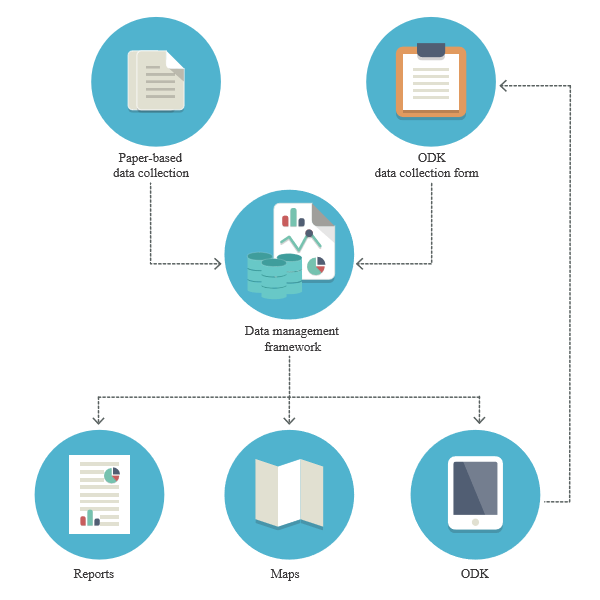The DTM information management system collects data through an extended network of key informants and regular field visits carried out by the RARTs. The system is aimed at identifying and verifying IDP locations, numbers and other profiling characteristics.
DTM components
The DTM information management system is articulated in four components which collect information on numbers, locations and selected characteristics of the IDP and returnee populations throughout Iraq to respond to the humanitarian community’s information needs. The four components have different time frames, population and geographic units of reference.
The four components are:
- IDP and Returnee Master Lists:
- Location Assessment:
- Safety Audit:
- Emergency Tracking:
 1. IDPs and Returnees Master Lists
1. IDPs and Returnees Master Lists
The IDP and Returnees Master Lists collect information on numbers and locations of IDP and returnee families through an ongoing data collection system that identifies and routinely updates figures through contacts with key informants. The unit of observation is the location.
Master Lists are fully updated in one calendar month, which means that information on all locations is updated once a month. In two weeks, approximately 50% of the locations are updated, data is sent to the IOM Information Management Unit, and the dataset with partial updates is released after quality control, while the teams continue to update information from the remaining locations. By the end of the month, the update is complete and the DTM report is published with fully updated information on IDPs and returnees.
Core information routinely collected is:
- Geographical (governorate, district, sub-district, location and GPS coordinates of the place of displacement/return where the population is identified).
- Governorate of origin for IDPs, and governorate of last displacement for returnees.
- Wave of displacement (the DTM conventionally identifies six displacement waves or periods: pre-June 2014; June-July 2014; August 2014; post-September 2014; Post April 2015; and Post March 2016 onwards).
- Shelter type (the DTM identifies four shelter category: Camps; critical shelter arrangements (informal settlements, religious buildings, schools; unfinished or abandoned buildings; and other formal settlements/ collective centers); private dwellings (host communities, rented houses, and hotels/motels); and unknown (applies to locations not accessible when the shelter type cannot be identified). DTM Shelter types definitions can be found here.
The DTM Master lists also collect additional operational information:
- Name, position and contact details of the key informant.
- Status of the update (i.e. new location; old location with updated information weather changed or unchanged; or not assessed in the current round).
- Date of the update.
- Location accessibility.
- Notes from the field.
The Master Lists collects information on the total number of families displaced or returned to a location at the time of data collection, not on new cases. Therefore, at every round of updates, the new count replaces the old count. The new count can be lower/higher than the previous count if the inflow is smaller/bigger than the outflow, or it can be zero if all IDPs/returnees left the place where they were previously identified. Once a location stops hosting IDPs or returnees, the DTM does not track personal IDP movements; that is, if specific families returned home, moved to a different shelter in the same location, or moved to a different location still away from home. Instead, the DTM methodology is designed to regularly monitor and update all IDP locations, thus enabling a continuous countrywide coverage of the main characteristics of the IDP population.
The IDP Master List was launched in December 2013 and the Returnee Master List in April 2015 (although returnee figures have been retroactively reported since October 2014).
2. Location Assessment (IDPs and Returnees)
The Location Assessment collects detailed information on IDP and returnee families living in locations identified through the Master Lists. The unit of reference of this assessment is the location, and information is collected at aggregate level, on the majority of IDPs and returnees living in a given location, and not on individual families.
Identified locations hosting IDPs and/or returnees (or both) are visited and directly assessed by the RARTs, who fill in a close-ended questionnaire with information collected through multiple interviews with several Key Informants and through direct observation.
2.1 Timeframe
At the start of the cycle, the list of locations identified in the Master Lists is given to the field teams and is used as the baseline for the Location Assessment. If new locations are identified during the assessment implementation, they are not included in the baseline and, hence, are not subject to assessment.
It takes approximately three months to assess all locations identified at the beginning of the data collection cycle. This process is periodically carried out using the most up-to-date Master Lists as baselines.
2.2 Coverage
The reported coverage refers to the number of locations assessed versus the baseline. Consequently, this geographical coverage does not aim to take into account the number of families living in the locations, because this number is fluid and can change between the date of the baseline and the date of the assessment.
2.3 Data collection and quality control
In addition to the direct observation of the location, IOM’s RARTs are instructed to interview several key informants (including members of the IDP and Returnee community) to get a comprehensive understanding of the situation in each location, and to cross-verify the information obtained. At the end of the key informant interviews, RARTs fill one (ODK) form with the summary of the information collected, and the data is then uploaded to the server and stored as one assessment. The system automatically performs quality checks and assigns a credibility score to the assessment based on four questions answered by the RARTs on the quality and consistency of the information collected (click here to download the detailed methodology).
2.4 Information collected through Location Assessments
Although there are different questions targeted to IDPs and returnees separately, information routinely collected by the Location Assessment is:
- Geographical information (governorate, district, sub district, location, and GPS coordinates of the place where the population is assessed).
- Governorate of origin.
- Wave/period of displacement.
- Shelter type.
- Reasons of displacement.
- Future intentions.
- Feeling of safety and security and common security incidents.
- Feeling of safety and security and common security incidents.
- SADD (Sex & Age Disaggregated Data).
2.5 Sex and age disaggregated data (SADD)
Sex and age disaggregated data (SADD) is collected on a random sample of 30 families of each group (IDPs and/or returnees or both) in each location. Age data is collected and aggregated into five-year age groups (0-5; 6-14; 15-24; 25-29; 60 and above). The 30 families are sampled randomly from the lists made available by the local authorities or by the representatives of the site (in the cases of a single site).
To obtain the overall number of individuals in each sex and age group in a given location, the percentage distribution of individuals in each sex and age group is calculated and re-proportioned against the total number of individuals living in one location, i.e. the percentage of IDP individuals in each sex and age group is multiplied by the total number of IDP individuals in the location.
Numbers are aggregated to represent sex and age figures at the district or governorate level. The precision of these estimates is variable: the higher the number of IDPs in a location, the less precise the estimates are. The precision decreases considerably when numbers are added up at a district or governorate level. Therefore, these numbers must be read with caution, taking into account the way they were collected and aggregated for analysis by the DTM.
2.6 Protection indicators in the Location Assessments
As part of a global initiative supported by several donors, IOM has enhanced the type of data collected by the DTM to include protection indicators in order to provide a more holistic picture of displacement and its consequences on the affected population. DTM Iraq, with support from SIDA and PRM, has engaged with protection actors to redesign data collection tools to include specific indicators informing GBV and protection risks, in particular, in relation to site layout and infrastructure, security, priority legal needs, protection issues, child protection concerns, women’s knowledge about the availability of GBV services in camps and camp-like settings and their active participation in the provision of such services.
By incorporating these indicators, the DTM tools allow for the identification of protection issues, thereby ensuring that humanitarian actors are well informed of the vulnerabilities and most pressing protection needs of the displaced populations in Iraq.
3. Safety Audit
IOM Iraq deployed a site-level assessment called safety audit as a component of the DTM aimed at identifying risks in IDP critical shelters across Iraq. This is part of the DTM global initiative to enhance gender mainstreaming in its data management systems, and is aligned with Inter Agency Standing Committee (IASC) Guidelines.
The Safety Audit evaluates site-level gender-based violence (GBV) risks associated to the physical structure, layout and provisions of critical shelter arrangements, and collects information on:
- Shelter and dwelling structure and layout.
- Water, Sanitation, and Hygiene facilities and services.
- Safety and security of the site.
- Safety and security of the site.
- Access to services.
4. Emergency Tracking
Activated on an ad hoc basis, the DTM Emergency Tracking provides early field reports at the beginning of a complex crisis, allowing IOM to gather, consolidate and disseminate baseline information on displacement and return figures at the onset of a newly emerging crisis.
The DTM Emergency Tracking relies heavily on information provided by RARTs or partners within the humanitarian community about an unfolding situation. The Emergency Tracking gathers data through IOM Iraq’s extended network of key informants, who provide basic information on the new displacement, be it of IDPs or returnees, or both, including numbers, location and shelter types.
While IOM DTM strives to provide best estimates, the Emergency Tracking aims to be a quick monitoring tool with real-time data turnover ranging from 24 to 72 hours following its activation. As displaced population movements are highly fluid, these emergency early reports require continuous verifications through multiple sources and data triangulation. Eventually, the DTM Emergency Tracking data feeds into the displacement data within the two-week DTM Master Lists reporting cycle and, therefore, data will be later verified and assessed through other components of the DTM methodology.
